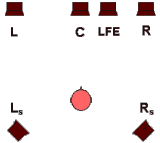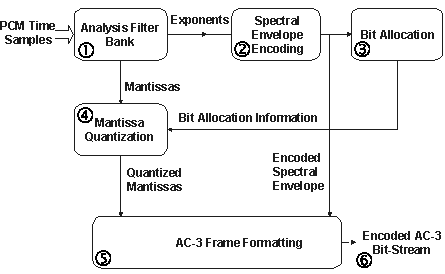AC-3: Difference between revisions
No edit summary |
No edit summary |
||
| Line 41: | Line 41: | ||
===Standards=== | ===Standards=== | ||
* http://www.atsc.org/standards/a_52a.pdf | * http://www.atsc.org/standards/a_52a.pdf | ||
[[Category:Codec]] | |||
Revision as of 06:40, 2 September 2006
Dolby AC3
AC-3 (Audio Code number 3) refers to a multichannel music compression technology that has been developed by Dolby Laboratories. The goal of this digital compression technology is to produce a digital representation of an audio signal which, when decoded and reproduced, sounds the same as the original signal, while using a minimum of digital information (bit-rate) for the compressed (or encoded) representation, providing true surround sound.
Over the past years Dolby Laboratories has used the term Dolby Digital to refer to this digital system in the film and theatre industries, and has used the term Dolby Surround AC-3 to refer to the system in the home theatre market. In practice both the cinema and home theater applications are variations of the same basic technology (slightly different data rates). So to minimize the possibility of confusion by consumers the Company has decided that Dolby's consumer multichannel digital format will be known by the same name used in the film and theatre industries ie Dolby Digital.
How does AC-3 work?
Like MP3 or AAC, AC-3 uses masking properties of sounds to achieve its compression. Input uncompressed PCM samples must be 32, 44.1 or 48 kHz on up to 20 bits.
- The first step in the encoding process is to transform the representation of audio from a sequence of PCM time samples into a sequence of frequencies coefficients blocks. This is done in the analysis filter bank. Overlapping blocks of 512 time samples are multiplied by a time window and transformed into the frequency domain. Due to the overlapping blocks, each PCM input sample is represented in two sequential transformed blocks. The frequency domain representation may then be decimated by a factor of two so that each block contains 256 frequency coefficients. The individual frequency coefficients are represented in binary exponential notation as a binary exponent and a mantissa.
- The set of exponents is encoded into a coarse representation of the signal spectrum which is referred to as the spectral envelope.
- This spectral envelope is used by the core bit allocation routine which determines how many bits to use to encode each individual mantissa.
- The mantissa is quantized according to the bit allocation informations.
- The spectral envelope and the coarsely quantized mantissas for 6 audio blocks (1536 audio samples) are formatted into an AC-3 frame.
- The AC-3 bit stream (from 32 to 640 kbps) is a sequence of AC-3 frames.
AC-3 utilizations
Dolby AC-3 is used intensively in the cinema at 640 kbps data rate. The THX quality label is also in 95% of the cases based on some AC-3 installations. It is used on laserdiscs at 384 kbps bitrate, and now in DVD at similar bitrates. The 5 channels of the old Dolby Pro-Logic are extracted from the 2 stereo channels, so they only reproduce parts of the audio spectrum range. As AC-3 provides only full range channels, its sound is really much better in terms of quality and spatialisation. You can notice that an AC-3 bitstream can carry a Pro-Logic signal in its two front channels for compatibility with old systems.
One of the main advantages of AC-3 is its utilization: since several years, it has intensively been used, so it became a real world "standard".
(article reproduced from http://www.mp3-tech.org)


